THE VIADUC DES ARTS—ARTISANS’ PRECINCT & ELEVATED LINEAR GARDEN OASIS
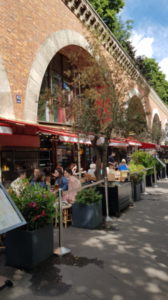
Built in 1859, this former elevated railway viaduct came into Paris from the east, terminating at Place de la Bastille in the 12th arr. After the creation of the RER A line in 1969 the Viaduc de Bastille became redundant, gradually declining into another example of neglect and decay that was slated for demolition. Instead, under a bold urban renewal program by the City of Paris in the 1980s, the Viaduc’s fortunes were revived.
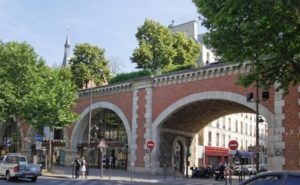
In the heart of the area known to locals as the Gare de Lyon/Bercy neighourhood, the rehabilitation of the Viaduc was not the first option, as there was a strong move to demolish it. It’s located on the edge of the now vibrant Bastille area, whose highlights include the ultra-contemporary Opera Bastille and the old-world charms of the rue de Charonne with its quaint and stylish boutiques, hip sidewalk cafes and nightlife. As was often the case with urban renewal in the 1970s, it was thought that it would be more appropriate to erect new buildings along the defunct stretch of the Viaduc, as a way of extending the rejuvenated Bastille area.
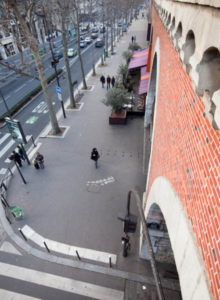
Luckily, the presence of a couple of well maintained buildings behind a section of the viaduct persuaded the urban renewal committee to rethink the issue. Their second option was to convert the railroad into an elevated promenade, and to make use of the arched spaces under the vaults as well as many of the derelict areas adjacent to it.
In 1983 the implementation of the Promenade Plantée concept, linking Place de la Bastille to the Bois de Vincennes, constituted one of the most important projects for the revitalisation of the eastern arrondissements of Paris. The first part of the Promenade opened in 1989.
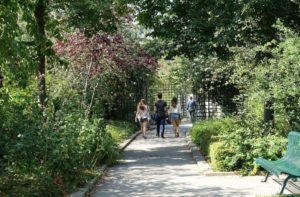
At times 10 metres above the street, along the almost 4.50 kms in length where once the trains ran, thousands of trees, shrubs, flowers and grasses have transformed it into a verdant space. Open from sunrise to sundown, the Promenade, or Coulée Verte (green belt, or course) is beloved by locals previously deprived of easy access to nature.
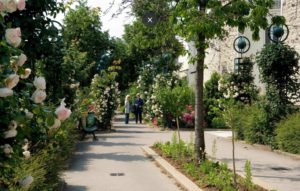
Now, they can enjoy seasonal delights such as blossoming cherry trees, trellises covered in roses, and lavender.
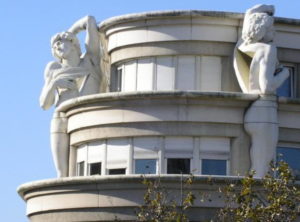
There are benches strategically placed to sit and relax, and it’s a lovely opportunity to appreciate the very fine architecture of many of the buildings—it’s a reminder too that we should look up more often while we’re walking the streets of this beautiful city.
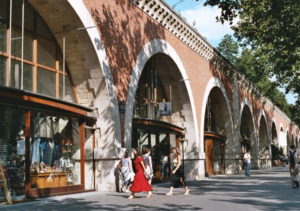
In 1988 an architectural team was chosen for the conversion of the arches under the viaduct into a strip of art galleries, artisan workshops and retail spaces for crafts professionals who were increasingly being forced out of the city due to high rents. The work started in 1994 and the last vaults to be completed were opened in 1997. The work mostly consisted of cleaning the viaduct and closing the vaults with glass walls on two sides. All up, this created 64 rentable vaulted spaces that stretch approximately 1.50 kms. along ave. Daumesnil.
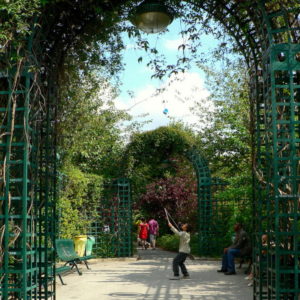
However, the Viaduc des Arts was not an instant success. As recently as five years ago, the French press were reporting on the struggles to attract clientele. Parisians were reluctant to head to a neighbourhood that for many, their only memory of it was as a rather dodgy area with little or nothing to attract them. For years, many of the arches were boarded up, there were a few motor mechanics’ workshops and garages, plus there was the perception that much of the area had been taken over by drug dealers. Certainly not the most attractive quartier in Paris!
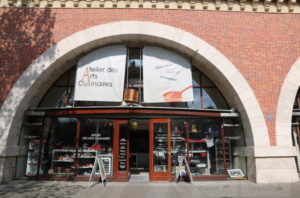
Fortunately, sufficient time has elapsed for unsavoury ‘enterprises’ to disappear and prejudices to fade away. Today, there are a number of new and enthusiastic artisans creating a fresh new dynamic for the Viaduc.
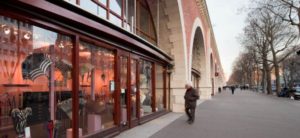
There are now 52 artisans of every sort imaginable, such as glass-blowers, jewellery designers, couturiers, textile designers, furniture makers and restorers, tapestry-makers and restorers, metal-smiths, leather workers, robotic and antique dolls, theatre set-makers, musical instrument makers and restorers, art conservators and galleries—a number of whom offer temporary exhibitions on themes such as Arts Professionals, the works of Mozart, pottery or African art. Some artisans are practicing arts that are fast disappearing, such as paper restoration and hand-made flute-making. You can relax with a coffee at a café, have dinner at one of the restaurants, or pick up something delicious at one of the numerous gourmet food havens.
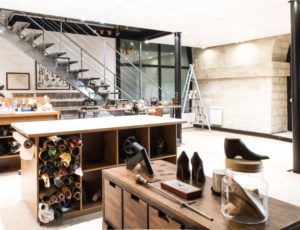
One such artisan is Philippe Atienza, a master craftsman shoemaker, located at 53, avenue Daumesnil. In his workshop the key word is authenticity. His collection of original old machines and tools are not only part of the décor, they are also used in the manufacturing process for all the shoes he makes there. He loves the atmosphere of the location and the stimulation of sharing creative ideas among others who share his fresh, contemporary approach to practising their skills and preserving their artisan traditions.
Some of the other fascinating ateliers to look out for include:
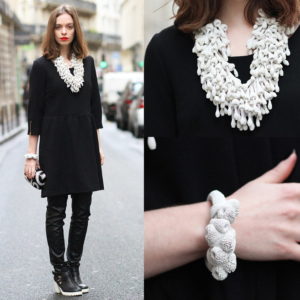
Tzuri Guela, a designer of textiles, jewellery and haute couture accessories; Atelier Dupond des Arts, which is a workshop specialising in fine hand-made guitars; Lily Alcaraz and Lea Berlier, who are textile designers specialising in artisanal weaving techniques; Jean-Charles Brosseau, who hand makes perfumes for men and women.

One very interesting artisan studio is L’Atelier Lilikpó, who create gorgeous, custom-made mosaic decorations in sumptuous colours and patterns.

Maison Fey, founded in 1910, specialises in leather-covered, stamped and embossed books, frames and furnishings. When you enter the shop, you’ll be amazed at the variety of calf-skin, goat and ostrich skins in every shade hanging from the ceiling. They also repair old leather boxes and re-upholster leather furniture.
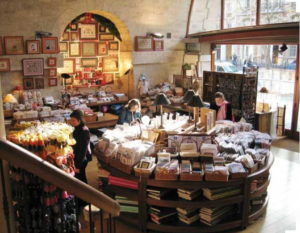
For those keen on needlework crafts, one of the most interesting shops is Le Bonheur des Dames at 17, ave. Daumesnil. Named after the novel, ‘The Happiness of Women’ by Emile Zola, the atelier was founded by Cécile Vessière in 1979. The artisans create colourful and elegant scenes of everyday life, combining embroidery techniques with Saxon, Celtic and Latin traditions. This shop is a must-visit for those looking for embroidery, petit point and cross-stitch kits and all sorts of haberdashery accessories. The atelier enjoys an international reputation—in Japan, Mme Vessière is recognised as one of the ten best artisans of France.
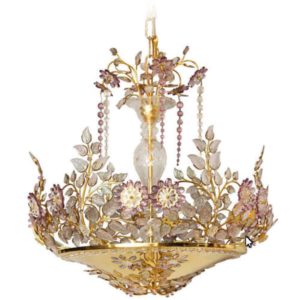
If you love traditional light fittings, seek out Maison Baguès at no. 73 ave. Daumesnil. Established in Paris in 1840, and originally specialising in liturgical bronze, the business grew rapidly by the end of the 19th century, thanks to the widespread use of electricity. Between the wars, the business expanded internationally, and branches were set up in New York, Rome and Cairo. Nowadays, they still specialise in traditional techniques to produce luxury light fixtures, such as iron and bronze lamps, chandeliers and wall lighting fixtures, which are hand-assembled and finished with unique patinas. Many of their original designs are still highly sought-after. The business is also renowned for its restoration of collectible pieces as well as custom designed balustrades and metal gates. Their lights can be seen in such famous hotels as The Ritz and George V in Paris and The Savoy in London.
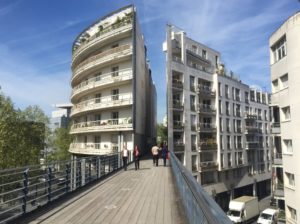
To find the Viaduc and the Promenade Plantée start from the beginning of avenue Daumesnil at rue de Lyon—the nearest metro is Bastille (Lines 1, 5 & 8).
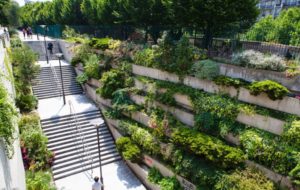
To access the elevated Promenade, look for one of the numerous staircases at various points on the ground that connects up to the garden.
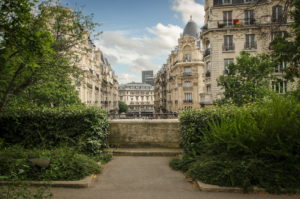
New York City also has its own re-purposed elevated railway with the High Line, with its first phase opening in 2009 and the third and final phase opening in September 2014. The Viaduc des Arts in Paris was the inspiration for this urban renewal project. A group of concerned New Yorkers formed a community group advocating the High Line’s preservation, and referenced the Viaduc des Arts in their successful submission to the New York City government. The then mayor, Rudy Giuliani, was very keen to see its demolition, but the considerable force of public opinion and fundraising events sponsored by prominent citizens eventually saw a change to the City’s policy.
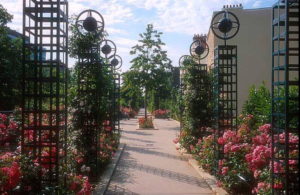
So when you’re next in Paris, check out the original of this great concept. Explore some fascinating artisan craft ateliers found nowhere else in the city, enjoy a peaceful break with a magical, green stroll above the city, followed by a relaxing coffee or glass of wine in a great little sidewalk cafe.
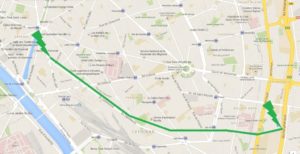


C’est magnifique, Cheryl et Graham: ? bravo! … et entre les
« boutiques artisanats » on vois plusieurs examples parfaits de la patrimoine intangible: ça m’intéresse beaucoup ??
Avez-Vous vus la promenade similaire à New York? Les vues architecturales sont aussi merveilleux ? ?
Chere Anna,
Je suis d’accord avec toi! C’est un tres bon, et tres interessant, example du patrimoine de la ville de Paris. On peut voir beaucoup des produits artisanales et les artisans eux memes.
No, we haven’t seen the High Line in NYC, which I hear is very good too. However, it comes as something of a surprise to most Americans to learn that the Viaduct des Arts of Paris came first, and was in fact used as a case study to persuade the New York city authorities to give the go-ahead for the High Line project.